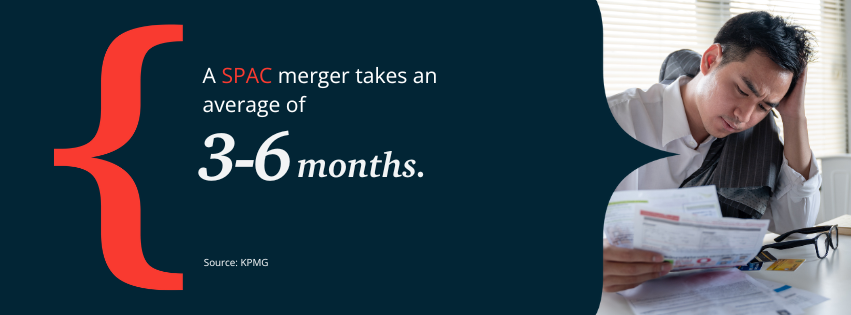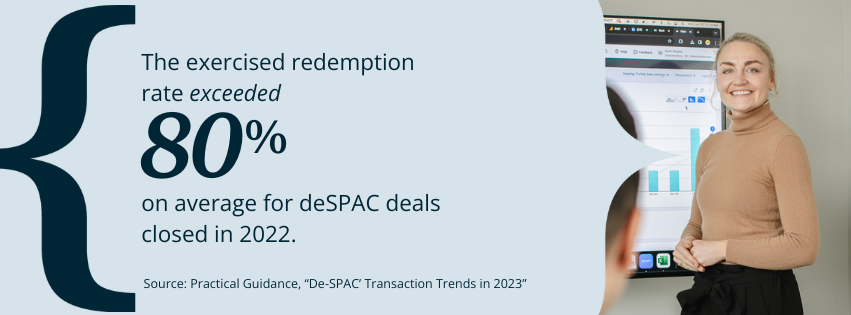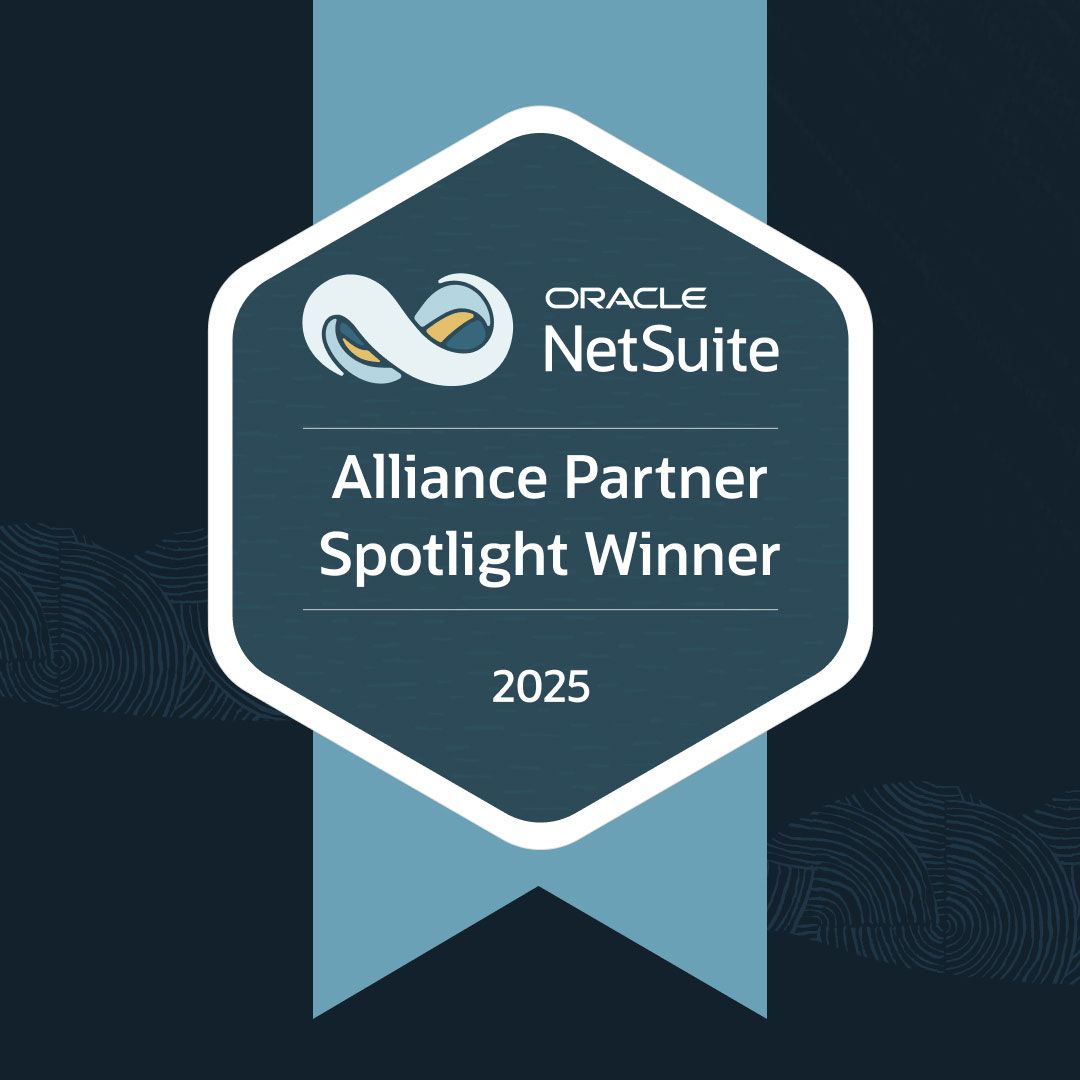5 Tricky Problems Facing a DeSPAC Merger and How to Overcome Them
Going public is never easy. Still, the right software can help you plan and prepare for market success.
There’s a good reason why businesses start trading publicly—because they have a chance to multiply their value. According to Nasdaq, the top 10% of public companies average 300% returns three years after their initial public offering (IPO).
Still, going public is a challenging process with significant risk. (Nasdaq also reports that two-thirds of companies underperform three years post-IPO.) Consequently, some businesses go public through a deSPAC transaction instead of the traditional IPO process. They hope the alternative route will set them up for public trading success.
Unfortunately, SPACs have advantages and disadvantages, so not every deal works out. We want your company to have the best chance on the public market, so we’ve assembled a quick guide to the deSPAC process. It explains a deSPAC transaction, why businesses do it, and how NetSuite software can help overcome some of its biggest challenges.
SuiteDynamics partners with NetSuite to implement and customize digital solutions that could make a difference in your deSPAC success. Schedule a free consultation with our team and prepare to blow the public market away.

What Is a SPAC?
A Special Purpose Acquisition Company (SPAC) is a shell company established by investors to acquire a private business and take it public. It offers an alternative to the traditional, often more complex, time-consuming IPO process.
What Is a DeSPAC?
The term “deSPAC” describes a private business's process of merging with a SPAC and becoming publicly traded.
The deSPAC process begins after the SPAC has raised funds through an initial public offering of its own and locates a private company for a merger. Regulatory bodies and SPAC shareholders must approve the merger before the private business can become public. Then, the SPAC is dissolved, leaving the once-private company a publicly traded entity.
Why Would a Company Choose a DeSPAC?
The deSPAC route to public trading has gained popularity recently because it has unique advantages compared to traditional IPOs.
Speed to Market: A deSPAC transaction can help you go public faster. Traditional IPOs involve a lengthy and complex process, including roadshows, financial audits, and regulatory approvals. A SPAC merger simplifies and speeds up this process. According to KPMG, a SPAC merger lasts 3-6 months on average, while a traditional IPO often takes about 12-18 months.
Certainty of Financing: The funds raised by the SPAC during its own IPO are held in a trust until it acquires a target company. Therefore, financing is already in place when executives reach a merger agreement. This process provides financial certainty that a traditional IPO, which is subject to market conditions at the time of the offering, might not offer.
Valuation Clarity: In a deSPAC transaction, SPAC sponsors negotiate the private company’s valuation upfront, providing clarity and potentially more control. Conversely, the market determines an IPO’s valuation through the order book-building process.
Experienced Management: A SPAC’s leadership often possesses significant industry and financial experience. Some private companies know relatively little about navigating the public market so that they can lean on SPAC teams for much-needed expertise regarding the merger process and the complexities of public trading.
Less Market Risk: Sponsors can negotiate the terms of a SPAC deal in advance. Therefore, private companies that merge with them can avoid market volatility that might affect a traditional IPO’s pricing and success. This is particularly helpful in uncertain market conditions.
Regulatory and Process Efficiency: The deSPAC process is still subject to regulatory review but can be more streamlined than the IPO route. Since a SPAC isn’t an operating company, it has no operations, liability, or debt and can speed through the IPO regulatory steps.
Strategic Partnerships: Some sponsors form SPACs to find a company in a specific sector. Consequently, they may offer capital, strategic partnerships, and networking opportunities that target companies find valuable.
A deSPAC transaction sounds enticing for all the reasons listed above, but it has downsides, too. Companies preparing for a merger must deal with regulatory and compliance issues, investor share redemptions, shortened IPO readiness timelines, and more.
Organizations considering this route should carefully weigh the pros and cons and consult with financial and legal advisors before deciding. However, if your company pursues a deSPAC transaction, you can use advanced financial and operating systems, like a NetSuite Enterprise Resource Planning (ERP) system, to help overcome several deSPAC obstacles.
SuiteDynamics experts can demo NetSuite for you during a free consultation so you can see how the system streamlines operations and boosts productivity. We can also answer questions about compliance and how the software will prepare your company for public trading.

How to Overcome the Challenges of a De-SPAC Transaction
A deSPAC merger presents unique challenges that require foresight, preparation, skillful management, and advanced technology. Below, we outline significant issues associated with de-SPAC transactions and strategies that sponsors and target companies can use to overcome them. We also highlight ways NetSuite software supports the process.
1. Regulatory and Compliance Hurdles
Going public—through an IPO or SPAC—subjects a company to strict regulations. Businesses must comply with a litany of requirements from the Securities and Exchange Commission (SEC) and other regulatory bodies.
Overcoming Strategy: Invest early in compliance infrastructure and seek advice from legal and financial advisors experienced in SEC regulations and public company reporting. Preparation for these regulatory demands ahead of the merger can smooth the transition.
NetSuite’s governance, risk, and compliance (GRC) solution offers the advanced visibility and security necessary to meet requirements. It establishes controls within your company and monitors their effectiveness. It also automates those controls, supports electronic audits, and helps manage overall risk.
2. Poor Public Trading Performance
Fluctuations in investor sentiment or broader market downturns can affect the performance of post-deSPAC stock.
Overcoming Strategy: A robust investor relations strategy will communicate clear, long-term growth prospects, and operational milestones can help stabilize performance. SPAC sponsors should also engage with long-term investors instead of focusing solely on speculative short-term traders.
According to a Harvard Business Review article, sponsors can look for PIPE (Private Investment in Public Equity) investors who agree to be locked in for up to six months.
“They take on this risk because they’re confident in the investment opportunity, they assume the merged entity will be thinly traded after the merger, and they’re offered subscription prices that are expected be at a discount to market prices,” it says.
3. Investor Redemption
The deSPAC process allows shareholders to redeem their investments before the merger. If too many reclaim their shares, they deplete the SPAC’s available capital. Unfortunately, that happens often. Practical Guidance’s “De-SPAC Transaction Trends in 2023,” says the exercised redemption rate exceeded 80% on average for deals closed in 2022.
Overcoming Strategy: To mitigate redemption rates, sponsors can negotiate agreements with PIPE investors to secure additional funding exempt from redemption. Bloomberg Law suggests that SPAC sponsors offer PIPE investors a portion of their common stock, warrants, or cash payments to illicit funding commitments.
4. Meeting and Maintaining Listing Requirements
After a deSPAC transaction, the newly public company must meet and maintain the listing requirements enforced by the exchange on which it is traded. Those conditions include maintaining the minimum share price, ensuring a sufficient number of publicly held shares, and adhering to corporate governance standards. Companies without prior public market experience may find these requirements difficult to meet.
Overcoming Strategy: Find financial advisors and underwriters experienced in post-SPAC challenges. They can offer solid advice on navigating market obstacles and keeping your business profitable.
5. Operational Readiness for Being Public
Some private companies appreciate a deSPAC transaction’s shorter timeline. Yet, what seems like a leg up for going public can become one of a business’s most significant challenges. PwC’s publication “European Companies Considering a US SPAC Merger” points out that a company must still complete several tasks before trading publicly; it just has fewer months to do so.
“With this short runway, companies often have difficulty budgeting adequate time and resources to complete necessary readiness activities for being a public company,” it says.
Those readiness activities include meeting enhanced reporting requirements, establishing solid investor relations, and boosting corporate governance standards.
Overcoming Strategy: There’s no major trick here besides excellent time management. Before the deSPAC merger, companies must prioritize fine-tuning their financial reporting, internal controls, and corporate governance practices to meet public company standards.
However, NetSuite’s cloud accounting software makes that preparation easier. It offers timely and accurate reporting and allows you to quickly and easily generate documents required by government regulations. The software also provides a historical view of financial and operating data you can use to attract new investors.
Schedule a free consultation with SuiteDynamics experts to discover how the system can change your company’s prospects. Our team can help prepare your business for public trading and streamline daily operations to maximize resources and skyrocket productivity.
Prepare for Public Trading Success with NetSuite
Public trading is risky whether your company enters the market by merging with a SPAC or using the traditional IPO method. Too many businesses undergo rigorous auditing and significant improvements only to fail on the public stage. We don’t want yours to be one of them.
NetSuite ERP software offers tools to help your company meet compliance regulations and thrive in the market. Its advanced financial capabilities ensure financial records pass audits and meet reporting expectations; its GRC solution establishes operational controls to mitigate risk, and its unified database streamlines operations.
The SuiteDynamics team can customize and implement a NetSuite system for your company that meets your unique needs and offers the best chance at public trading success. Together, we’ll ensure your business thrives on the market.
We pull information from NetSuite material, SuiteDynamics experts, and other reliable sources to compose our blog posts and educational pieces. We ensure they are as accurate as possible at the time of writing. However, software evolves quickly, and although we work to maintain these posts, some details may fall out of date. Contact SuiteDynamics experts for the latest information on NetSuite ERP systems.
Part of this text was generated using GPT-3, OpenAI’s large-scale language-generation model. After generating the draft language, our team edited, revised, and fact-checked it to ensure readability and accuracy. SuiteDynamics is ultimately responsible for the content of this blog post.











